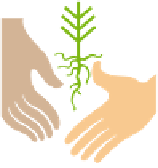Environmental Engineering Reference
In-Depth Information
Ray Anderson
Ray Anderson
(Figure 17-A) is
CEO of Interface, a
company based in
Atlanta, Georgia.
Interface is the
world's largest commercial manu-
facturer of carpet tiles, with 26 fac-
tories in six countries, customers in
110 countries, and more than $1 bil-
lion in annual sales.
Anderson changed the way he
viewed the world—and his busi-
ness—after reading Paul Hawken's
topic
The Ecology of Commerce.
In
1994, he announced plans to de-
velop the nation's first totally sus-
tainable green corporation.
Since then, Anderson has imple-
mented hundreds of projects with
the goals of zero waste, greatly re-
duced energy use, and eventually
zero use of fossil fuels by relying on
renewable solar energy.
By 1999, his company had re-
duced its resource waste by almost
30% and reduced its energy waste
enough to save $100 million. One of
Interface's factories in California
runs on solar cells to produce the
world's first solar-made carpet.
To achieve the goal of zero
waste, Interface plans to stop selling
carpet and lease it as a way to en-
courage recycling. For a monthly
fee, the company will install,
clean, and inspect the
carpet on a monthly
basis, repair worn carpet
tiles overnight, and re-
cycle worn-out tiles
into new carpeting. As
Anderson says, “We
want to harvest yester-
day's carpets and recy-
cle them with zero scrap
going to the landfill and
zero emissions into the
ecosystem—and run the whole
thing on sunlight.”
Anderson is one of a growing
number of business leaders who
are committed to finding more
economically and ecologically
sustainable ways to do business
while still making a profit for stock-
holders. Between 1993 and 1998,
Interface's revenues doubled and
its profits tripled, mostly
because the company
saved $130 million in
material costs with an
investment of less
than $40 million.
Andersen says he
is having a blast.
INDIVIDUALS
MATTER
Figure 17-A
Ray Anderson
17-4
REUSE
discarded TV sets, computers, and cell phones, is
shipped to China, India, Pakistan, and other (mostly
Asian) countries where labor is cheap and environ-
mental regulations are weak. Workers there—many of
them children—dismantle the products to recover
reusable parts and are thus exposed to toxic metals
such as lead, mercury, and cadmium. The remaining
scrap is dumped in waterways and fields, or burned in
open fires, which exposes the workers to toxic dioxins.
In cities such as Manila, the Philippines; Mexico
City, Mexico; and Cairo, Egypt, large numbers of peo-
ple—many of them children—eke out a living by scav-
enging for food scraps and for materials they can sell
for reuse or recycling from open city dumps (Fig-
ure 17-6). This practice exposes them to toxins and in-
fectious diseases.
Trade-Offs: Advantages and Disadvantages
of Reuse
Reusing products is an important way to reduce
resource use, waste, and pollution in developed
countries, but can create hazards for the poor in
developing countries.
Reuse involves cleaning and using materials over and
over, thereby extending the typical life span of a prod-
uct. This form of waste reduction reduces the use of
matter and energy resources, cuts pollution and waste,
creates local jobs, and saves money. Traditional forms
of reuse include salvaging automobile parts from
older cars in junkyards and salvaging bricks, doors,
fine woodwork, and other items from old houses and
buildings.
In today's high-throughput societies, we have in-
creasingly substituted throwaway tissues for reusable
handkerchiefs; disposable paper towels and napkins
for reusable cloth ones; throwaway paper plates, cups,
and plastic utensils for reusable plates, cups, and sil-
verware; and throwaway beverage containers for re-
fillable ones. We even have disposable cameras.
In contrast, reuse is thriving in most developing
countries but can pose a health hazard for the poor.
About 80% of the United States' e-waste, including
Solutions: Using Refillable Containers
Refilling and reusing containers uses less resources
and energy, produces less waste, saves money, and
creates local jobs.
Tw o examples of reuse are refillable glass beverage
bottles and refillable soft-drink bottles made of poly-
ethylene terephthalate (PET) plastic. Typically, such
bottles make 15 round-trips before they become too
damaged for reuse and then are recycled. Reusing






